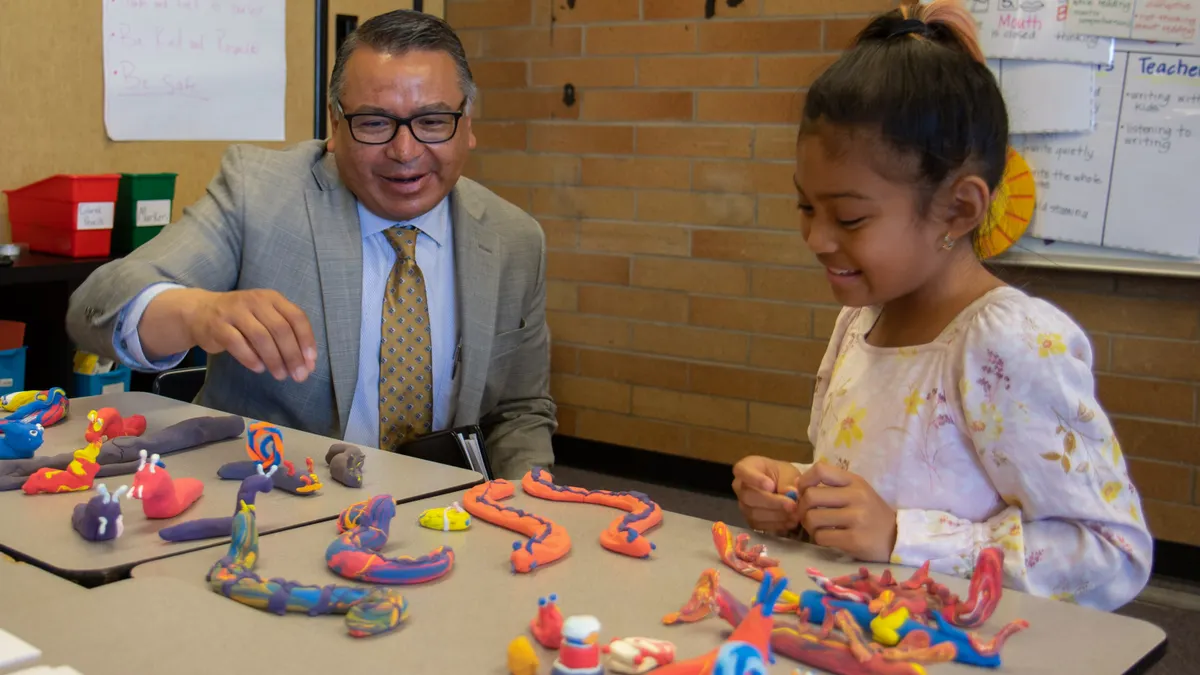While most the festivities at this year's conference of the International Society for Technology in Education (ISTE) began Monday, the sessions kicked off Sunday evening with an opening keynote from neuroscientist, author, professor and inventor David Eagleman.
But before Eagleman spoke ISTE CEO Richard Culatta greeted the packed Skyline Ballroom in Chicago’s McCormick Place convention center, saying that while he gets to visit a lot of schools and see amazing things happening, there's still room for improvement in teaching a lot of things, including digital citizenship. The topic, he said, has become more focused on online safety than on respectful interaction and discourse online. He noted that digital citizenship isn’t a list of “don’ts,” but a list of “do’s.”
Digital citizenship is NOT online safety. It's so much more. #iste18 #wcpssISTE18 pic.twitter.com/81dvmCSiT0
— Katherine Heywood (@keheywood) June 24, 2018
“Our ability to recognize truth from fiction is essential to our survival as a society,” Culatta said, adding that we have to evolve with the times and develop new skills to do that. But these skills have to be taught in context, as it’s hard to transfer things learned in the context of one environment to another.
As an example, he said that if we only teach what respectful debate looks like in the classroom, we shouldn’t be surprised when students aren’t respectful in a comment on a blog.
Tweet us! Pick one digital citizenship goal that you want to commit to. Use #digcitcommit & #ISTE18. pic.twitter.com/VUNK2QnyyM
— ISTE (@iste) June 24, 2018
Additionally, he highlighted the newly updated ISTE Standards for Education Leaders, which you can find more details on below, as well as the recently announced EdTech Advisor and ISTE Connect, an online collaboration tool. The organization is also offering ISTE U, an online learning platform offering graduate-level credit to educators who complete courses.
And finally, he detailed the pending launch of ISTE Certification for educators, with more details to come during Tuesday’s general session.
Culatta then introduced Patricia Brown, a technology specialist from St. Louis’ Ladue School District. Brown told the audience she believes digital media can change how people interact with the world, and that living in Ferguson, Mo., she has seen very clearly how conversations about police violence have grown from the killing of Michael Brown in 2014.
Powerful message from Patricia Brown at #ISTE18 on current race relations in the United States. pic.twitter.com/wNYGlUZfke
— Jesse Lucas (@kumujesse) June 24, 2018
Students in her district also made the news when they walked out over what they saw as unfair disciplinary practices against students of color, and elementary students staged a peaceful protest after a crossing guard had racial slurs yelled at him by a motorist.
Teaching in a predominantly white district, she says that authentic conversations and honest dialogue about race must happen, however, for healing to occur. She realized that students were ready to have these conversations, but adults were still uncomfortable. She encouraged attendees to “find your tribe,” seeking out people willing to advocate and speak up, and using digital media to spread the call for change.
EdTechTeam Chief Program Officer Jennie Magiera then led a panel of students ranging from high school to college age, discussing their efforts to promote student voice. Among their efforts: community organizing, the launch of a platform to help student activists gather, a student group focused on cultivating tough conversations on intersectional feminism and inclusivity, and an effort to bring coding to underserved communities.
Hey #ISTE18! Please follow the amazing student community leaders appearing on tonight's @ISTE Keynote Panel! @roserezac @kiarajeniece @MarleyRosario @dreamhustlecode pic.twitter.com/HEepXfCtxt
— Jennie Magiera (@MsMagiera) June 24, 2018
How do you empower students to change the world? Let them be themselves, show them how to find answers (not just give them the answers), provide them social emotional guidance and support, focus on the positive things students do to lift them up #iste18 pic.twitter.com/QPPFZaNORf
— Heidi Neltner (@heidinelt) June 24, 2018
Eagleman launched into his keynote with a look “under the hood” at the brain, which he described as the “most complicated device we’ve found anywhere in the universe.” It’s three pounds and consists of 86 billion neurons, each as complicated as an entire city with 500 trillion connections. We’re unable to describe it and have to invent new mathematical models to explain it, he said.
“I want my car to run as well as possible, but I don’t care about or want to know about how the engine works.”
— Michael Roush (@mdroush) June 24, 2018
About the same as being an educator and not learning more about how the brain works!#iste18 pic.twitter.com/eqr34xJ5H8
The distance between inputs and outputs distances us from other animals, as well as a larger prefrontal cortex. Compared to other animals, which are up and running within hours of birth, human babies are also born “half-baked” and take longer to develop.
Eagleman cited concern about students’ digital exposure and its impact on attention spans, but resisting changes like that actually set education back. How your brain turns out depends on what you do and what you’re exposed to. Brain plasticity results in the brain adjusting based on new knowledge gained, and technology affects neuroplasticity. Certain pathways are stronger, and certain pathways are taken away. This has, of course, influenced students' learning styles, with more “just in time” knowledge where things are learned in the context they’ll be used, more multitasking, and different comfort zones when learning.
Digital natives even read text differently based on their early experiences. So incredibly how our brain adapts to our world. (Blue is how people in our generation scan text; red is our students) @iste #iste18 pic.twitter.com/TrDkK8XdzR
— Leah Stafford (@leahcstafford) June 25, 2018
It’s difficult, however, to study the internet’s impact on the current student group because there’s no good control groups to understand it, Eagleman said.
It’s on educators to meet Gen-Z students halfway — asking students to present their work or rephrase the question or collaborate via peer grading and learn from each other.
“We all learn best when things are frustrating but they’re achievable,” Eagleman said.
Ultimately, the way tech has changed the brain and set expectations for learning has opened new opportunities for personalized education.
ISTE unveils new Standards for Education Leaders
Over the past few years, ISTE has updated each of its sets of standards. This year, it tackled those aimed at school administrators. Based on feedback from educators and leaders in all 50 states and 36 countries, ISTE's Standards for Education Leaders are focused on guiding education leaders as they work to help their schools and districts integrate technology to innovate and reimagine teaching and learning. And they tie into a number of the biggest hot topics in education today, including equity and digital citizenship.
In full, they are:
- Equity and Citizenship Advocate: Leaders use technology to increase equity, inclusion and digital citizenship practices.
- Visionary Planner: Leaders engage others in establishing a vision, strategic plan and ongoing evaluation cycle for transforming learning with technology.
- Empowering Leader: Leaders create a culture where teachers and learners are empowered to use technology in innovative ways to enrich teaching and learning.
- System Designer: Leaders build teams and systems to implement, sustain and continually improve the use of technology to support learning.
- Connected Learner: Leaders model and promote continuous professional learning for themselves and others.
Student privacy experts discuss the arduous task of navigating privacy laws
A morning panel, led by the Future of Privacy Forum's Amelia Vance, focused on the intricacies of navigating student privacy regulations.
Vance said that since 2013, 119 laws have been passed in 39 states specifically on student privacy. And for the first time in 2014, a state (California) passed a law specifically aimed at educational technology vendors with the Student Online Personal Information Protection Act (SOPIPA). InnovateEDU's Bill Fitzgerald chimed in that the Protection of Pupil Rights Amendment is perhaps "the most underrated privacy law we have."
The Family Educational Rights and Privacy Act (FERPA), however, is likely the best known. Passed in 1974, it provides parents and eligible students the rights to access their educational records and decide how that data is used. There are 17 exceptions, including the school official exception, which allows officials to disclose personally identifiable information to other school employees and third-party contractors.
But these third parties must be providing educational services the district would otherwise provide themselves, that it be in line with what the district has set for use, and that the district/school must still exercise direct control over what the vendor can do with the data. The vendor can also only use the information in the context of being school officials and can’t redisclose or sell that information without the school’s permission, and even then, it can't be outside of what FERPA allows.
More information is available from the U.S. Department of Education, including guidance that details how metadata can be used, as that becomes an even more complex issue.
In summation, though, U.S. Department of Education (ED) Director of Privacy Policy Michael Hawes advised that if parents would "freak out" about the data being collected, you need to reconsider why you're collecting that data and how it's justified. He also advised that ED has a student privacy help desk via its student privacy page, with an average response time of about four business days. Sara Kloek of the Software and Information Industry Association, also participated in the discussion.
CTOs go to bootcamp
In an afternoon session, Jeremy Shorr of the Teaching Institute for Excellence in STEM led Gurnee School District 56 (Ill.) Director of Technology Phil Hintz, Kentucky Department of Education Chief Digital Officer Marty Park, Mountain Brook Schools (Ala.) Technology Director Donna Williamson and Pickerington Schools (Ohio) Educational Technology Director Brian Seymour through a conversation on best practices in IT management.
For a full recap of their discussion, click here.
Cisco unveils corporate social responsibility ed initiative
- Cisco on Monday announced the launch of "Global Problem Solvers: The Series," an animated series with related curriculum focused on teaching students to become global citizens and think like entrepreneurs and technologists to solve global problems and affect social change.
- The problems addressed in the series run a spectrum of social, economic and environmental issues, and emphasize the use of skills like complex problem solving, critical thinking, creativity, people management and collaboration.
- "GPS: The Series" is available at no cost in English, Spanish, Hindi and French, and a multiyear pilot program is ongoing with Arizona State University and public schools in the Phoenix, Ariz., area.
RoboKind's Jett expands STEM education to students with autism
- RoboKind, the company behind the facially expressive robot Milo for educating students with autism, is now working to expand STEM opportunities around coding and programming with a new robot named Jett.
- Jett and its corresponding curriculum are designed to address the growing number of students on the autism spectrum and the 70-75% rate at which autism spectrum disorder (ASD) individuals are unemployed or underemployed by offering an entry point to those skill sets.
- Jett's curriculum is organized in a project-based, self-paced manner that doesn't require educators to have previous experience or background in coding, focusing instead on empowering students to self-direct their learning without requiring interaction with others — a scenario that alleviates discomfort for students on the autism spectrum.



















